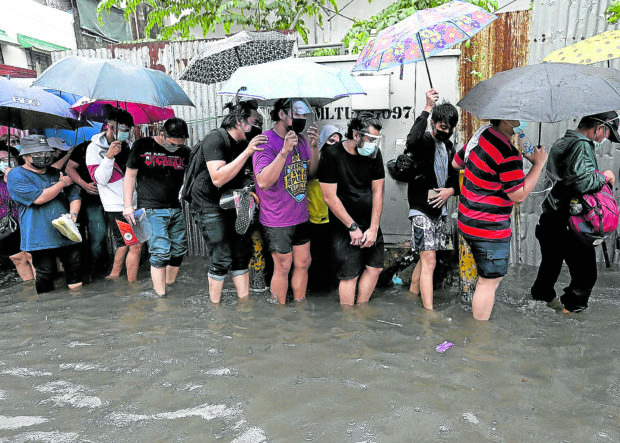For COVID jab, Manila folk brave flood, added health risks

ADDED RISK Residents and workers stand in the rain and wade through floodwaters on Wednesday—risking infection from waterborne diseases—just to get into San Andres Sports Complex in Manila, one of the COVID-19 vaccination hubs in the city. —RICHARD A. REYES
MANILA, Philippines — Neither rain nor flood dampened the COVID-19 vaccine rollout in Manila on Wednesday, indicating Filipinos’ willingness to get the jab, but also presented a potential health risk from waterborne diseases.
Thousands waded through ankle- to knee-high floodwaters to get into San Andres Sports Complex, one of many vaccination hubs in the capital city.
Ana Michelle Malonzo, an employee of a fast-food restaurant, said she had no choice but to await her turn, even in the flood, because getting jabbed was a requirement for work.
Philip Tuliao queued for a CoronaVac shot in the rain. “I don’t mind getting wet as long as I can get a vaccine. I have this raincoat, anyway,” he told Inquirer Radio.
‘Rain will not stop us’
The city government allocated 2,997 doses of various vaccine brands to the San Andres hub for seniors, persons with health issues, workers and members of indigent communities.
Article continues after this advertisement“Rain and flooding will not stop us, just as COVID-19 doesn’t … rest,” Mayor Francisco “Isko Moreno” Domagoso said. “We can assess [the situation] later but rest assured the city government of Manila will not stop [the vaccination].”
Article continues after this advertisementThe mayor had earlier vowed to step up Manila’s pandemic response following the detection of the Delta variant in the city.
Home vaccination
But Dr. Rontgene Solante, an infectious diseases expert at Manila’s San Lazaro Hospital and a government adviser on COVID-19 vaccines, said local governments could suspend the rollout for a day if the situation warranted it.
“You can’t risk lives just to get vaccinated. With the ‘habagat’ and flooding, the next problem could be leptospirosis,” Solante said in a Viber message, warning of an increase in such cases in the next weeks due to the wet season.
Solante said the city government may shift to home vaccination during days of heavy rainfall to keep people from having to risk their health outdoors.
He also recommended that personnel at local vaccination hubs advise people to wear protective shoes, or simply to avoid flooded areas.
Solante said residents should now inquire with their barangay health officers about taking doxycycline prophylaxis if exposed to contaminated water.High-risk cities
Speaking later at the Malacañang press briefing, Solante said there now appeared to be local transmission of the highly contagious Delta variant.
Independent pandemic monitor Octa Research on Wednesday flagged 11 cities as high risk for COVID-19, based on such factors as high average daily attack rate (Adar), ICU (intensive care unit) utilization and positivity rates.
The 11 cities are Davao, Cebu, Iloilo, Bacolod, Makati, Cagayan de Oro, General Santos, Baguio, Taguig, Laoag and Mariveles.
According to Octa, Davao continued to log the highest average number of new cases, with around 218 new infections daily from July 14 to 20. The city’s ICU utilization rate was also tagged as “very high” at 91 percent.
The ICU utilization rate in Iloilo and Taguig were also pegged at “very high,” with 99 percent of ICU beds in use in Iloilo and 92 percent in Taguig.
High positivity rates
Bacolod, Cagayan de Oro, General Santos, Baguio and Laoag have very high positivity rates, while Laoag and Mariveles have very high Adar at 47.87 and 28.53, respectively. Octa measures Adar as the number of new daily cases for every 100,000 people. An Adar above 10 is considered high-risk.
Other cities that have an Adar higher than 10 are Davao, Cebu, Iloilo, Makati, Bacolod, General Santos and Baguio.
Octa said the COVID-19 reproduction number of Metro Manila had risen to 1.08. A reproduction number higher than 1 indicates sustained transmission of the virus.
DOH bulletin
In its daily case bulletin, the Department of Health (DOH) said it had recorded 6,560 new COVID-19 infections, bringing the total number to 1,524,449.
There remain 47,996 active cases, of which 92.1 percent are mild. Another 1.8 percent are asymptomatic, 1.6 percent are critical, 2.6 are severe and 1.84 are moderate.
The DOH also said another 5,364 patients had recovered, bringing the total number of survivors to 1,449,579.
At the Malacañang press briefing, Solante said “elimination strategies,” such as border controls, compliance with minimum public health protocols, avoiding superspreader events, as well as testing, tracing and isolation programs, should be intensified in order to stop the spread of the Delta variant.
Citing the cases documented by the Philippine Genome Center, Solante said he believed that “there is a local transmission of the Delta variant.”
Vaccine rollout
He said the government should also continue with its vaccine rollout “because all vaccines, at this moment, are still working and will work especially against these variants of concern.”
According to Solante, the symptoms of those infected by the Delta variant do not differ from those infected by the original virus: cough, fever, myalgia, headache, sore throat, and loss of smell and taste.
But it has been observed that those afflicted by the Delta variant tended to have a higher viral load, which could increase their risk of getting hospitalized, he said.
“So this is why with one interaction, a single individual can infect as [many] as eight to as [few] as four. Overall, it is 97-percent highly transmissible,” he said.
Solante also said the Delta variant’s high transmissibility and high reproduction rate also meant that it could spread more in households than in other areas.